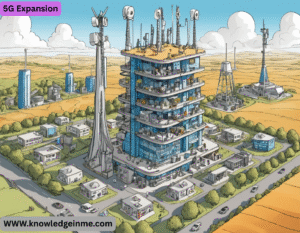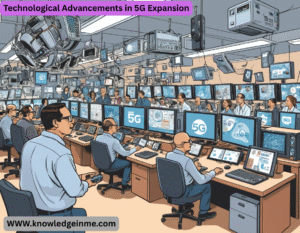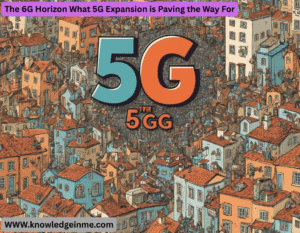5G Expansion The global expansion of 5G technology is transforming industries, enabling faster connectivity, lower latency, and greater network capacity. Here’s an overview of the current state and future outlook of 5G expansion:
1. Current Global 5G Deployment 2024-2025
Leading Countries:
- China has the largest 5G network, with over 1 million base stations covering all major cities.
- USA: Major carriers (Verizon, AT&T, T-Mobile) offer nationwide 5G, with mm Wave deployments in urban areas.
- South Korea & Japan: Early adopters with near-complete 5G coverage in cities.
- India: Rapid rollout with Reliance JIO and Airtel deploying 5G across key cities.
Coverage:
- Urban areas have the highest penetration, while rural regions lag due to infrastructure costs.
- Sub-6 GHz is the most widely deployed, while mm Wave (ultra-fast but short-range) is limited to dense areas.
2. Key Drivers of 5G Expansion
- Demand for High-Speed Internet: Consumers and businesses need faster speeds for 4K streaming, AR/VR, and cloud gaming.
- Industrial IoT (LLOT): Factories and logistics rely on ultra-low latency for automation and robotics.
- Smart Cities: 5G enables real-time traffic management, surveillance, and energy efficiency.
- Telemedicine: Remote surgeries and health monitoring depend on reliable 5G connections.
3. Challenges in 5G Expansion
- Infrastructure Costs: Deploying small cells and fiber backhaul is expensive.
- Spectrum Allocation: Governments must allocate mid-band (3.5 GHz) and mm Wave (24-40 GHz) efficiently.
- Security Concerns: Risks of cyberattacks on critical 5G-dependent infrastructure.
- Health & Environmental Debates: Some groups raise concerns over radiation and energy consumption.
4. Future Trends 2025-2030
- 5G Advanced (5.5G): Expected by 2026, bringing AI-integrated networks, better energy efficiency, and 10Gbps speeds.
- Private 5G Networks: Enterprises will deploy dedicated 5G for factories, ports, and campuses.
- 6G Research: Already underway, with potential commercialization by 2030.
Technological Advancements in 5G Expansion
Network Evolution: NSA vs. SA 5G
- Non-Standalone (NSA) 5G: Uses existing 4G LTE core for control, offering faster speeds but not ultra-low latency.
- Standalone (SA) 5G: Fully independent 5G core, enabling <1ms latency, network slicing, and massive IoT support.
Deployment status:
- China leads in SA 5G (used for smart factories, autonomous vehicles).
- USA & Europe transitioning gradually (T-Mobile, Vodafone, Deutsche Telekom have active SA deployments).
Spectrum Bands & Their Impact
Band Frequency Coverage Speed Use Case
Low-band <1 GHz Wide ~100 M bps Rural coverage
Mid-band 1-6 GHz (e.g., 3.5 GHz) Balanced 300 M bps – 1 G bps Urban/suburban
mm Wave 24-100 GHz Short-range 1-3 G bps Stadiums, dense cities
Trend: Mid-band (C-band, 3.5 GHz) is the sweet spot for most 5G deployments.
C. 5G-Advanced (5.5G) The Next Leap
Expected by 2026, featuring:
- AI-native networks (self-optimizing, predictive maintenance)
- 10 G bps peak speeds (vs. 1-2 G bps today)
- Reduced energy use (critical for sustainability)
- Integrated sensing & communication (enabling smart roads, drones)
2. Economic & Industry Impact
- A. Market Growth Projections
- 5G-enabled industries:
- Manufacturing ($740B potential by 2030 – smart factories, predictive maintenance).
- Healthcare ($76B – remote surgery, wearable monitoring).
- Autonomous Vehicles ($800B – V2X communication).
B. Job Creation & GDP Boost
- 5G could add $1.3 trillion to global GDP by 2030 (IHS MARKIT).
- New jobs: Network engineers, AI specialists, IoT developers.
C. Business Adoption Challenges
- High costs (private 5G networks require major investment).
- Skill gaps (need for 5G-trained workforce).
3. Geopolitical & Regulatory Factors
A. US-China 5G Race
- Huawei ban (US, UK, Australia) shifted supply chains to Ericsson, Nokia, Samsung.
- China’s dominance: Holds 40% of global 5G patents (vs. US at 15%).
B. Europe’s Delayed Rollout
- Fragmented spectrum policies slowed deployment.
- Now catching up with Open RAN (cost-effective, vendor-neutral networks).
C. Developing Nations (India, Africa, Lat Am)
- India: Rapid rollout but affordability remains a challenge.
- Africa: Limited to major cities (South Africa, Nigeria, Kenya).
- LATAM: Brazil & Mexico leading, but infrastructure gaps persist.
4. Emerging 5G Use Cases
A. Smart Factories & Industry 4.0
- AR-assisted assembly lines (remote expert support).
B. Autonomous Vehicles & Drones
- Vehicle-to-Everything (V2X): Real-time traffic updates, collision avoidance.
C. Metaverse & Extended Reality (XR)
- Cloud gaming (Nvidia GeForce Now, Xbox Cloud Gaming).
- AR/VR workplaces (Microsoft Mesh, Meta Horizon Workrooms).
- D. Precision Agriculture
5. Future Outlook: What’s Next
- 2025-2026: Wider 5G SA adoption, more private networks.
- 2026-2030: 5.5G rollout, early 6G research (THz frequencies, AI-driven networks).
- Beyond 2030: 6G commercialization (potential speeds of 1 T bps, holographic COMMS).
The Next Frontier: 5G Network Slicing & Edge Computing
A. Network Slicing (The “Killer Feature” of 5G SA)
- What it is: Virtual partitioning of a single 5G network into multiple dedicated “slices” for different use cases.
Game-changing applications:
- Emergency services slice: Guaranteed bandwidth for first responders.
- Gaming slice: Ultra-low latency (<10ms) for cloud gaming.
- Industrial IoT slice: Isolated, ultra-reliable network for factory robots.
Deployment status:
- Challenge: Requires full 5G SA cores—most networks still hybrid (NSA).
B. Edge Computing + 5G = Distributed Intelligence
- Why it matters: Moves AI processing closer to devices (factories, smart cities).
Breakthrough use cases:
- Real-time video analytics: Smart traffic lights that detect accidents instantly.
- Tactile Internet: Remote surgery with haptic feedback (surgeon “feels” resistance).
2. The Dark Side of 5G Expansion: Risks & Unresolved Issues
- A. Cybersecurity Threats Amplified by 5G
- New attack surfaces:
- Orchestration layer hacking: Manipulating network slices.
- Controversy: Huawei’s alleged backdoors (despite no public evidence).
B. Energy Consumption: The Dirty Secret
- 5G base stations consume 3x more power than 4G (Nokia study).
Solutions:
- AI-driven sleep modes: Shuts down unused antennas.
- Renewable-powered sites: Vodafone’s UK wind/solar towers.
C. Health Debates: Science vs. Misinformation
- Conspiracy theories: 5G-caused COVID spread (debunked but persistent).
3. Disruptive Business Models Enabled by 5G
A. “5G as a Service” (5GaaS)
- Example: BMW leases a private 5G slice from Deutsche Telekom for its factory.
- Revenue shift: TELCOS becoming cloud-style service providers.
B. The Rise of Neutral Host Networks
- Concept: Single 5G infrastructure shared by multiple carriers (e.g., stadiums).
- Economics: Cuts deployment costs by 40% (Deloitte estimate).
C. Micro-Operator Models
- Localized 5G networks:
- Farm co-ops running private 5G for precision agriculture.
- Mining companies deploying underground 5G for autonomous drills.
4. The 6G Horizon: What 5G Expansion is Paving the Way For
A. 6G’s Potential (2030+)
- Terahertz (THz) bands: 100+ G bps speeds (theoretical).
- AI-native air interface: Self-learning waveforms.
- Holographic COMMS: Lifelike 3D projections.
B. 5G’s Role in the 6G Transition
Foundation technologies:
- Network slicing → Quantum-secured slices in 6G.
- Edge AI → Distributed swarm intelligence.
1. The Quantum-5G Convergence 2026-2030
Next-Gen Synergies Emerging:
- Post-Quantum Cryptography in 5G: NIST-approved algorithms being baked into 3GPP Release 19 to counter quantum hacking threats
- Quantum Key Distribution (QKD) Backbones: China’s 4,600km quantum network now integrating with 5G SA cores for ultra-secure government/military COMMS.
- Quantum Computing + Network Slicing: Dynamic slice optimization using quantum annealing (D-Wave trials with SK Telecom)
2. The Hyperlocal 5G Revolution
Micro-Operators Going Guerrilla:
- Neighborhood 5G Co-ops: Brooklyn’s “Citizen Broadband” initiative – residents pool CBRS spectrum licenses
- Underground 5G Meshes: London Tube deploying leaky feeder cables with 5G small cells (3.5GHz penetrates better than Wi-Fi)
- Disaster-Response Pop-Up Nets: SpaceX’s Star link + 5G picocells in Maui wildfires achieved 250Mbps emergency comms
3. The Dirty War Beneath 5G
Covert Infrastructure Battles:
- Submarine Cable Sabotage: 97% of intercontinental 5G traffic flows through undersea cables (recent Baltic cuts)
- Semiconductor Cold War: ASML’s 5nm EUV machines becoming geopolitical weapons (TSMC’s 5G RF chips bottlenecked)





